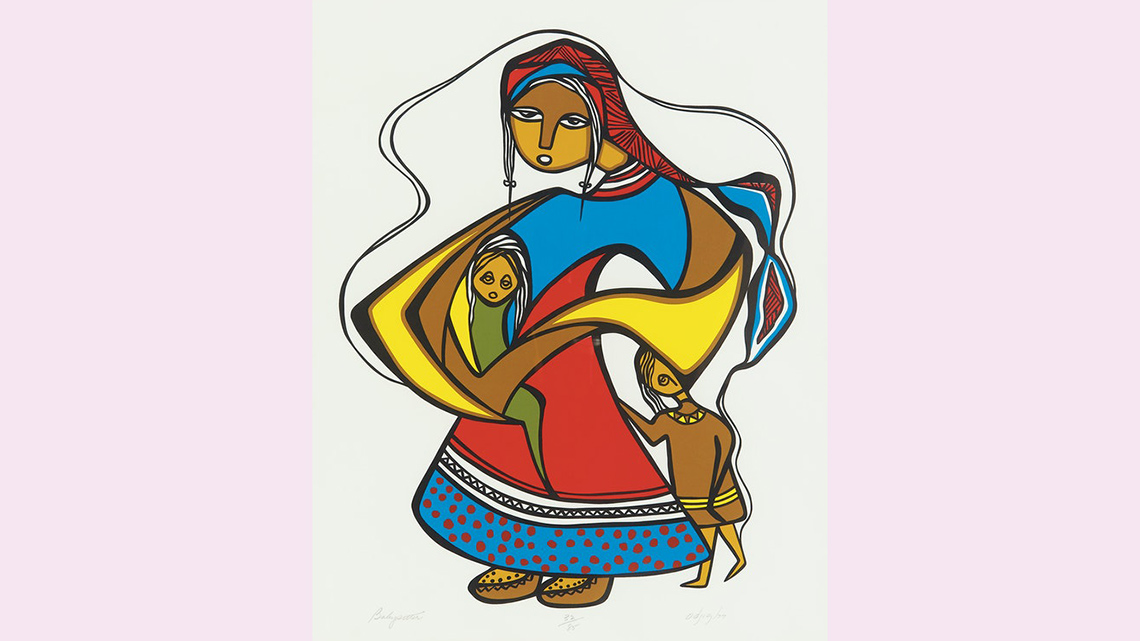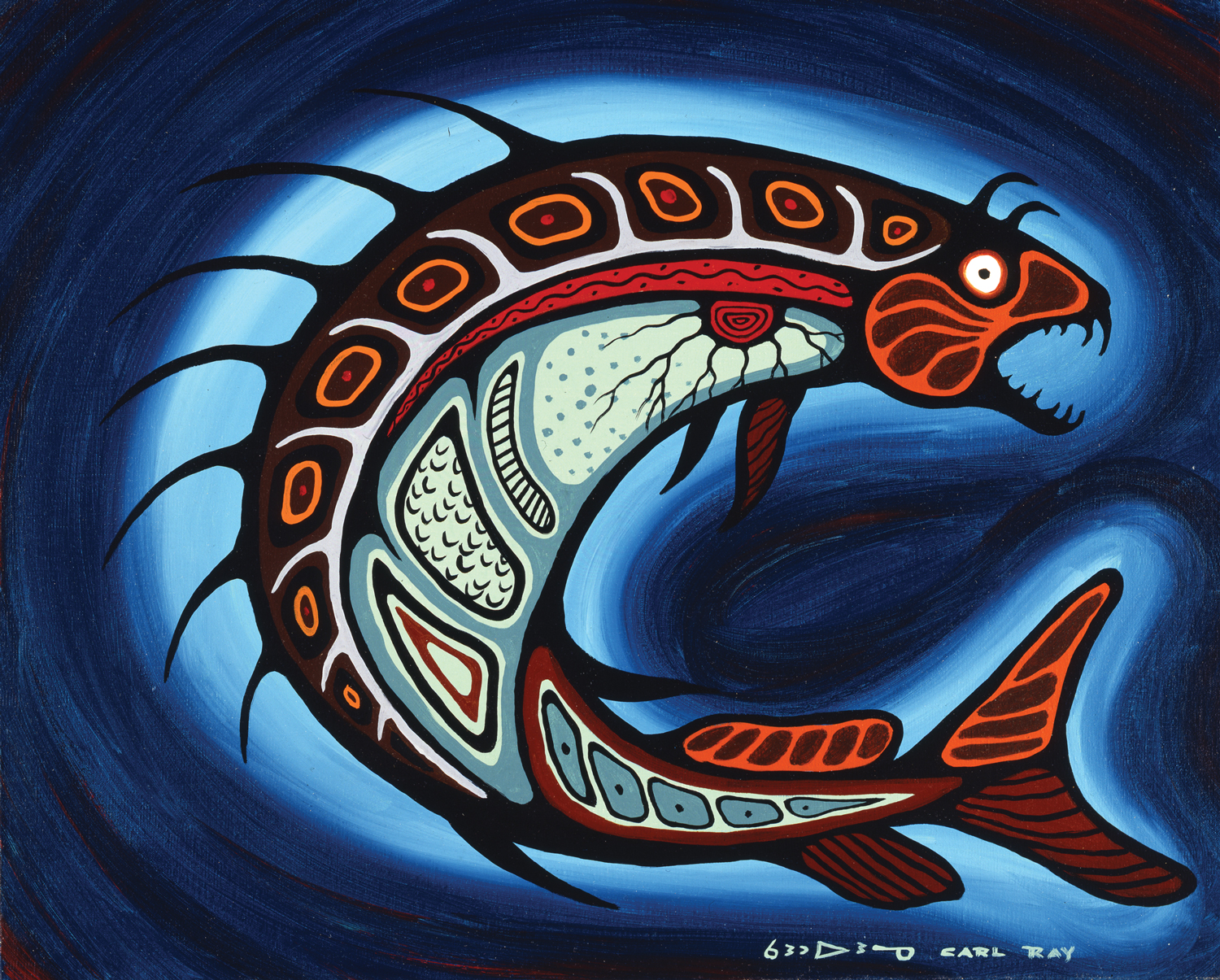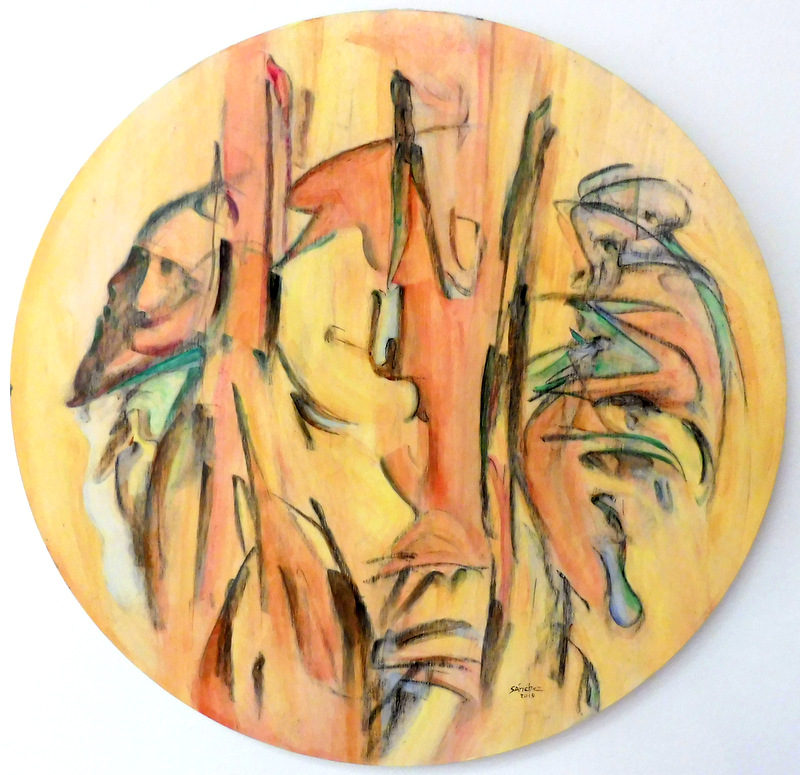Minds On
Let’s get started!
Notice and wonder
What do you notice about the painting?
What do you think of when you explore this painting?
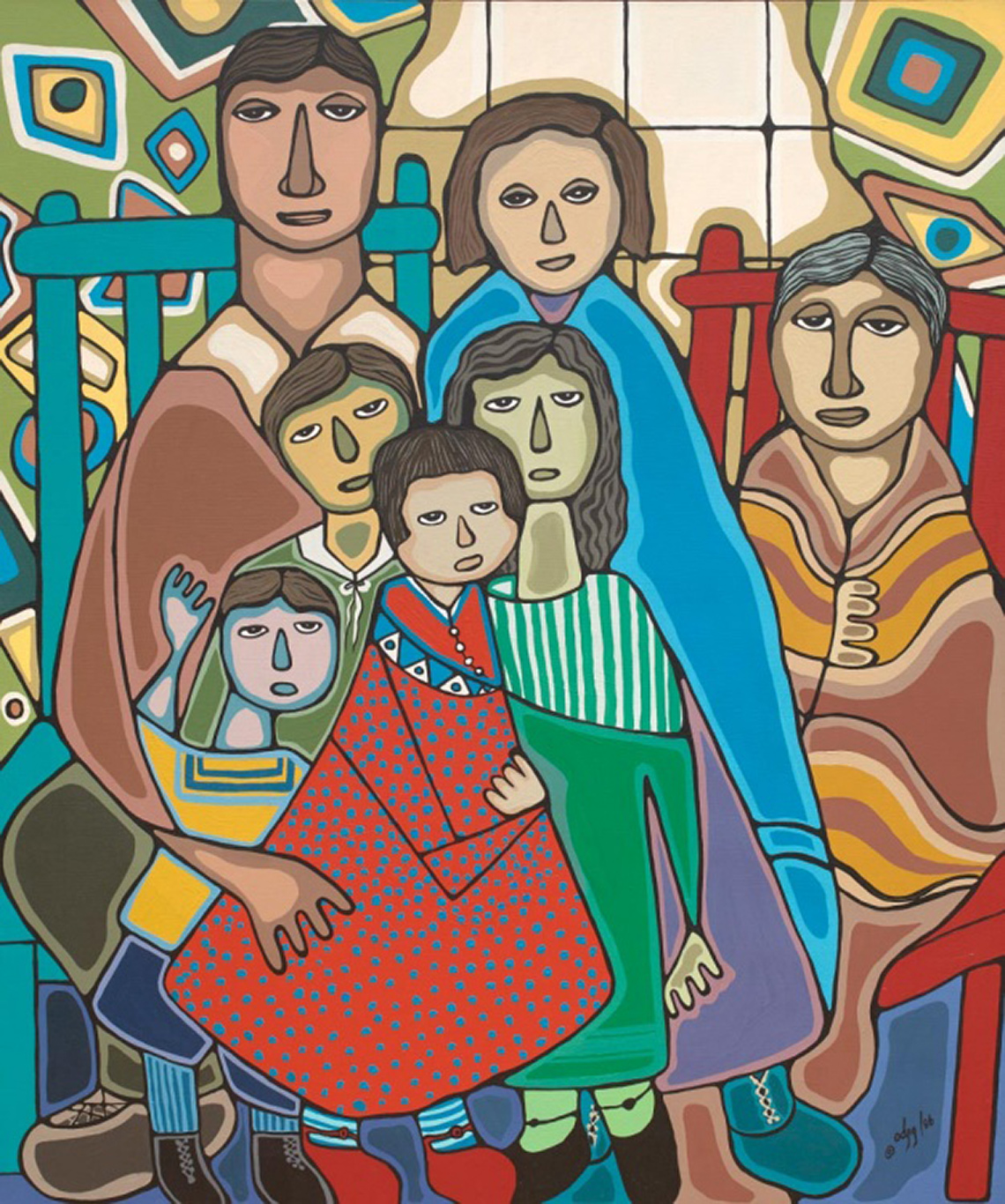
Odjig Family; Father, Mother, Grandfather, Stanley, Daphne, Donald, Winnie, Xmas, Dec 25th by Daphne Odjig, 1988
Record your ideas using a method of your choice.
Share your thoughts with a partner, if possible.
Action
Get ready, get set…
Daphne Odjig
The painting that you explored in the Minds On was by Daphne Odjig. She created the portrait of her family.
Daphne Odjig was an Anishinaabe (Potawatomi and Odawa) artist. She was from Wikwemikong Unceded Territory, a First Nations community on Manitoulin Island. She learned how to draw and carve from her grandfather. She grew up to create beautiful drawings and paintings which shared her Anishinaabe culture and traditions.

Did You Know?
The Anishinaabe
The Anishinaabe means the “people from whence lowered” or “original person” and includes the Odawa, Chippewa, Ojibway and Saulteaux, Oji-Cree, Mississaugas, Algonquin, Nipissing, and Potawatomi nations. These nations share common histories, languages, and cultural values. Anishinaabe territory spans the Great Lakes region as well as what is now referred to as northern Ontario, western Quebec, southern Manitoba, eastern Saskatchewan, and into the northern United States. The Ojibway (Chippewas), Odawa, and Potawatomi Nations formed the Three Fires Confederacy over 1000 years ago and it still remains today.
Daphne Odjig helped start the 1970s artists’ alliance Professional Native Indian Artists Inc., more commonly known as the Indigenous Group of Seven. She created artwork for over 60 years that helped share Anishinaabe perspectives, identity and cultural values. Odjig and the Indigenous Group of Seven were important to help encourage Indigenous artists to share their work in Canada. She also helped to create the first Indigenous-owned gallery in Canada.
The Indigenous Group of Seven
For a long time, Canadians did not know very much about Indigenous peoples. They weren’t taught very much about First Nations, Inuit, or Métis peoples in school or through newspapers or television. Most of what they did learn did not reflect the true history or lived experiences of Indigenous peoples or their rich and vibrant cultures, traditions, identities, and families.
Indigenous art is based on cultural and community knowledges, teachings, and lived experiences. These forms of art have also been treated differently both in the past as well as in the present.
Western views were used to explore all art forms throughout history. This meant that Indigenous art forms were not recognized and not included in many art galleries.
In the 1970s, a collective of Indigenous artists formed The Professional National Indian Artists Inc., more commonly known as the Indigenous Group of Seven.These artists are:
- Jackson Beardy (Cree)
- Eddy Cobiness (Ojibway)
- Alex Janvier (Dene, Saulteaux)
- Norval Morrisseau (Ojibway)
- Daphne Odjig (Potawatomi, Odawa)
- Carl Ray (Cree)
- Joseph Sanchez (Pueblo, Spanish, German)
Explore the following artwork by Norval Morrisseau, Daphne Odjig, Carl Ray and Joseph Sanchez.
A carousel of four images. Image 1: Floral Theme in Two Parts, Norval Morrisseau. It has a blue background and shows a two-part image facing each other. In each section is a red, orange, and pink flower with two blooms and 4 green leaves. Each leaf is green with an orange circle filled with yellow and red circles. There are two birds on either side resting on the flowers. They appear to be looking at the other side of the painting at each other. The birds have a black outline with layers of oval colours of purple, pink and yellow. Image 2: Babysitter, Daphne Odjig. There is central figure with a long braid and wearing a blue and red dress. Hiding behind this figure is a small child with one arm on the back of the larger figure. There is another small child in this figure’s arms. The arms of the larger figure are yellow. The small children are more muted coloured, in brown and green. Image 3: Spirit Fish, Carl Ray. An orange, red, brown and light blue fish is curved in a c shape with it's mouth open. It has teeth and thin spikes on its back and sits against a dark blue background with light blue highlighting the outline of the fish. Image 4: Broken Promises, Joseph Sanchez. It is an abstract work that uses a colour palatte of yellows, oranges, pinks, and a little splash of green and blue. Through shading, colour, and use of lines, it communicates a message.
Why was the Indigenous Group of Seven an important part of Canadian art?
Press ‘Sample Answer’ to learn why the Indigenous Group of Seven was important.
Together, they brought more representation and recognition to Indigenous art and artists in Canada. They also kept their cultural teachings within their work so Indigenous people would feel pride in these pieces and never forget where they came from.
Their work challenged Canadian society to recognize the beauty in Indigenous art and think about Indigenous histories and worldviews.
Family portrait
Daphne Odjig included creation stories, personal stories and ideas about history, and politics in her artwork. She used solid colours and bold lines, natural shapes, and contours that also show inspiration from Cubism and Surrealism styles.
Cubism
Cubism is an art movement where objects and figures are depicted using multiple perspectives of the same subject combined into a single image. Cubism was started by Pablo Picasso and Georges Braque in 1908 and lasted into the 1920s.
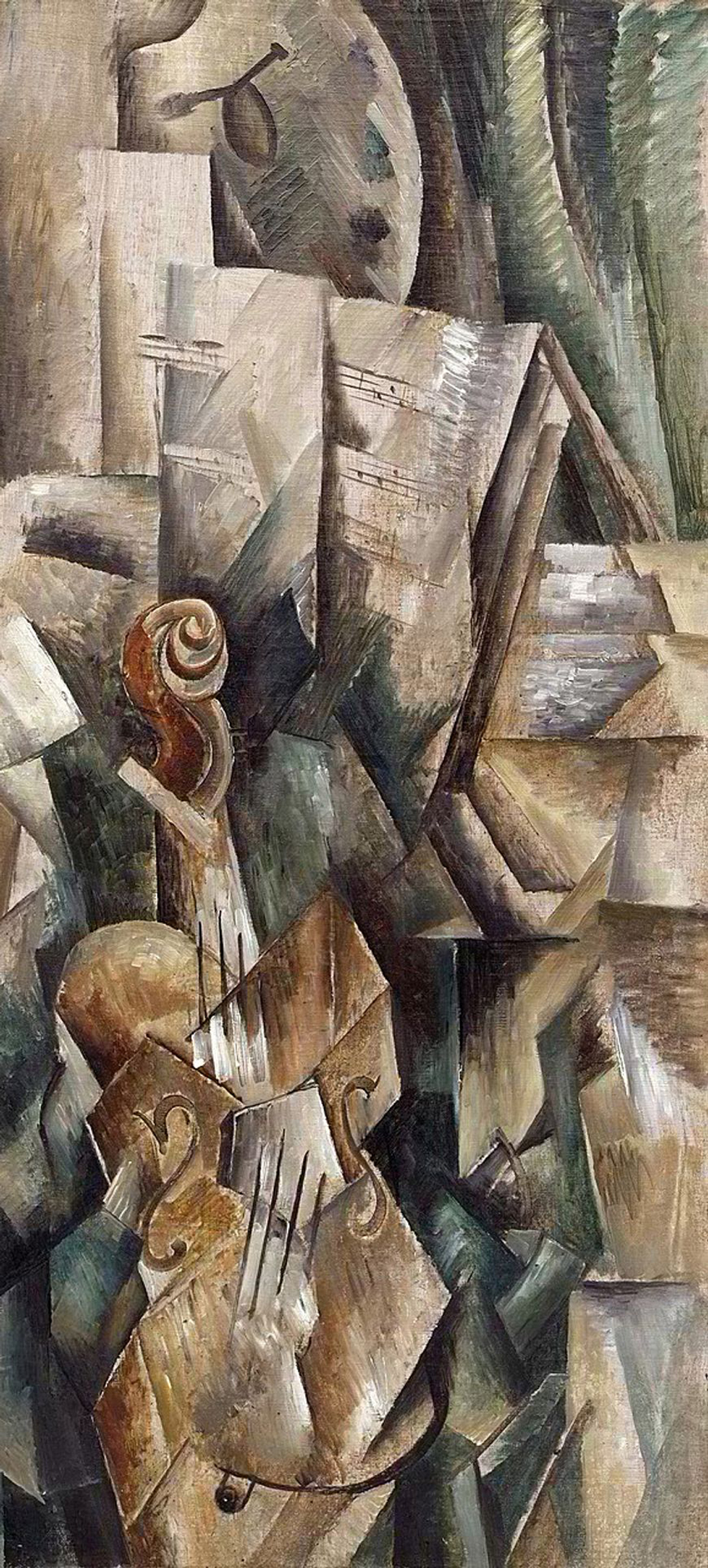
Violin and Palette by Georges Braque, 1909–10
This piece is considered cubism. Multiple perspectives of the same violin, sheet music, and palette are combined into one image. These objects are made of geometric shapes including but not restricted to rectangles, squares, triangles, rhombus, cylinders.
Surrealism
Surrealism is an art movement started by Andre Breton in the 1920s. Surrealist art is inspired by dreams. A lot of surrealist art combines objects and ideas that you would not expect to be placed together.
Salvador Dalí was a Spanish artist who created work in the Surrealist style.

The Persistence of Memory by Salvador Dali, 1931
This piece is considered surrealism. The profile of a human face is flattened and draped over a rock in a desert. To the left of the face is a platform with a dead tree growing out of it. There are melting clocks draped over the single branch of the tree, over the edge of the platform, and over the human face. There is a solid clock face-down on the platform that is covered in ants. In the background there are cliffs next to a body of water.
Let’s return to Daphne Odjig’s family portrait.
Consider the painting now that you know more about the artist and her style of painting.

A painting of the Odjig family. This includes father, mother, grandfather, Stanley, Daphne, Donald and Winne. The family is gathered in front of two chairs. The figures overlap. Father, mother and grandfather are standing in the back, while the children are grouped in front. Each figure is outlined in black, and their clothing is made of organic shapes and vibrant colours. Some of the clothing items include polka dot, and striped patterns. Their clothing is made of complimentary colours and contrasts with one another.
Odjig Family; Father, Mother, Grandfather, Stanley, Daphne, Donald, Winnie, Xmas, Dec 25th by Daphne Odjig, 1988
How many people do you notice are in this family portrait?
Press ‘Sample Answer’ to access the number of people in the family portrait.
There are seven people in this family portrait.
How does Daphne Odjig use line, shape, and colour to create her family portrait?
Press ‘Sample Answer’ to access how Daphne Odjig uses line, shape, and colour.
The artist used curved lines, overlapping shapes to create depth, and a variety of different deep colours.
She creates outlines around the figures in her painting and complementary colours which creates contrast.
Complementary colours are colours that are directly opposite each other on the colour wheel (e.g red and green, blue and orange, yellow and violet).
What might this painting show an audience about Anishinaabe family and life?
Press ‘Sample Answer’ to learn what this painting might show about Anishinaabe family and life.
This painting shows multiple generations living together. The grandmother lives with the parents and children. Their overlapping shapes shows that they are close and connected. The grandmother has her own chair which shows her special place in the family.
How does this painting make you feel?
Go!
The Oneness of it All
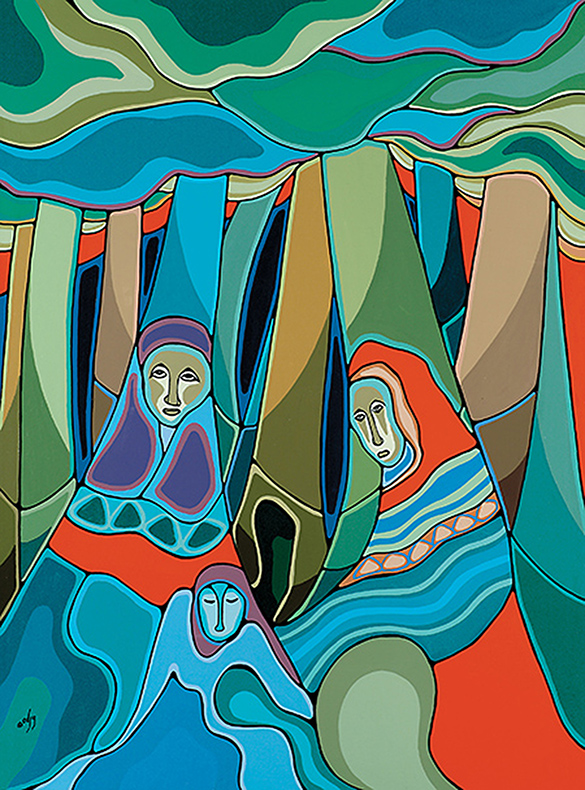
The Oneness of it all by Daphne Odjig, 1985
This piece of art is called The Oneness of it all. Odjig uses lines, shapes that overlap and contrasting colours. The colour palette for this painting is blue, green, purple, brown and orange. There are many trees behind the 3 human figures that all have trunks of brown, blue or green. The top of the painting is a swirl of blue, green and brown lines and shapes. The figures are shaped as trunks of trees and blend into the landscape of the painting. Their colours include purple, orange, blues and greens.
Let’s explore another of Daphne Odjig’s paintings called The Oneness of it All. But before we explore this painting, it helps to learn more about the cultural context of an artwork to understand its intended meaning.
In art, and in life, it is important for people to learn about different cultures so that they can treat everyone in a respectful and kind way. Cultural differences not only make people unique but also provide different perspectives or ideas when understanding the world. These differences make our communities stronger and better!
Indigenous worldviews offer a different perspective than Western or European perspectives. Indigenous perspectives consider the interconnectedness of all living things. Though distinct, most if not all Indigenous worldviews believe that the land, the waters, the sun, the moon, the rocks, the hills, the mountains, the wind, the sky, etc., all have a spirit and are animate, living things. Within many Indigenous languages, the names for the rocks, the lands, and the waters are described using animate language to acknowledge the spirit that lives within each. Within Indigenous worldviews, it is understood that all of the elements in the universe are connected, and are all dependent on one another for life. Humans are not superior to any other living part of the Earth rather they must live in harmony with nature.
Now that you’ve learned more, explore the painting again and answer the following questions.
Based on the name of the painting and the imagery, what message do you think Odjig is trying to convey to her audience?
Press ‘Sample Answer’ to learn the message Odjig is trying to convey.
The artist is trying to show that everything is connected. The painting is called “The Oneness of it All” meaning that all parts of nature, including humans, are connected to one another. We are all part of creation and we rely on nature to survive. The waters run through the trees and connect with the same colours of the sky. She illustrates grandmother images in the trees to reflect how the trees are our old and wise teachers. They care for us and watch over a younger person in the waters.
How did Daphne Odjig use colour, line, and/or shape in the painting? Do you recognize any principles of design reflected in this work?
Press ‘Definition’ to access the definition of principles of design.
Guidelines used to create art. Principles of design are also used to consider what an art piece may mean. The qualities include balance, emphasis, harmony, movement, proportion, rhythm, unity, and variety.
Press ‘Sample Answer’ to learn how Daphne Odjig uses colour, line, and shape in the painting.
Daphne Odjig used warm and cool colours in her painting. She overlapped the shapes of the trees to create depth and outlines each shape to create contrast. She creates repetition by including patterns in the foreground of the painting.

What are you curious about in this painting? If you could ask Odjig three questions about this painting, what would you ask?
Record your thoughts using a method of your choice.
Consolidation
Putting it all together
Spiritual Renewal
Explore the painting Spiritual Renewal by Daphne Odjig.

Spiritual Renewal by Daphne Odjig, 1984
This piece of artwork is divided into two sections through the centre. One the left there are traditional figures, both Indigenous and European figures. On the first are Indigenous figures that have come together. One figure is drumming, and the others are gathered around the drummer. The colours on the traditional side of the painting are muted, using blacks, whites, and browns, mostly where the colours on the other side, where the figures are gathered together are brighter and include blues, oranges, yellows, greens, reds, and browns. The figures on the right side, gathered around the drum, all are created with lines that blend together where the figures on the left, in the more traditional side, overlap but do not blend together as much.
What is your first impression? How does it make you feel?
How many faces can you locate in this painting?
How did Daphne Odjig use colour, line, and/or shape in the painting? Do you recognize any principles of design reflected in this work?
Why might Odjig have included so many different representations in her piece titled Spiritual Renewal?
What might Daphne Odjig be communicating in this painting?
Press ‘Sample Answer’ to learn what Daphne Odjig might be communicating.
This painting illustrates the different ways people connect with their spirit and culture. There isn’t one way to do this. Daphne Odjig grew up in a time where there wasn’t a lot of pride in being Indigenous or Anishinaabe and I think this piece is meant to inspire people to be proud of who they are and where their ancestors come from.
Complete the Spiritual Renewal Analysis Chart in your notebook or using the following fillable and printable document. If you would like, you can use speech-to-text or audio recording tools to record your thoughts.
|
What is your first impression? How does the painting make you feel? |
|
|
How many faces can you locate in the painting? |
|
|
How did Daphne Odjig use colour, line, and/or shape in the painting? Do you recognize any principles of design reflected in the work? |
|
|
Why might Odjig have included so many different representations in her piece titled Spiritual Renewal? |
|
|
What might Daphne Odjig be communicating in this painting? |
Press the ‘Activity’ button to access Spiritual Renewal Analysis Chart.
Portfolio
Track your progress
“If my work as an artist has somehow helped to open doors between our people and the non-native community, then I am glad. I am even more deeply pleased if it has helped to encourage the young people that have followed our generation, to express their pride in our heritage more openly, more joyfully than I would have ever dared to think possible.”-Daphne Odjig

This is a quote from the artist Daphne Odjig. What do you think Daphne Odjig meant when she says “encourage the young people that have followed our generation, to express their pride in our heritage more openly, more joyfully…”?
Press ‘Definition’ to learn the meaning of the word heritage.
Heritage is the knowledge and understanding passed down from generation to generation.
What have you learned about the artist Daphne Odjig and her artwork?
What else would you like to know about Daphne Odjig?
Are there other Indigenous artists that you would like to explore?
Record your thoughts in your portfolio or using a method of your choice.
Reflection
As you read through these descriptions, which sentence best describes how you are feeling about your understanding of this learning activity? Press the button that is beside this sentence.
I feel…
Now, record your ideas using a voice recorder, speech-to-text, or writing tool.

